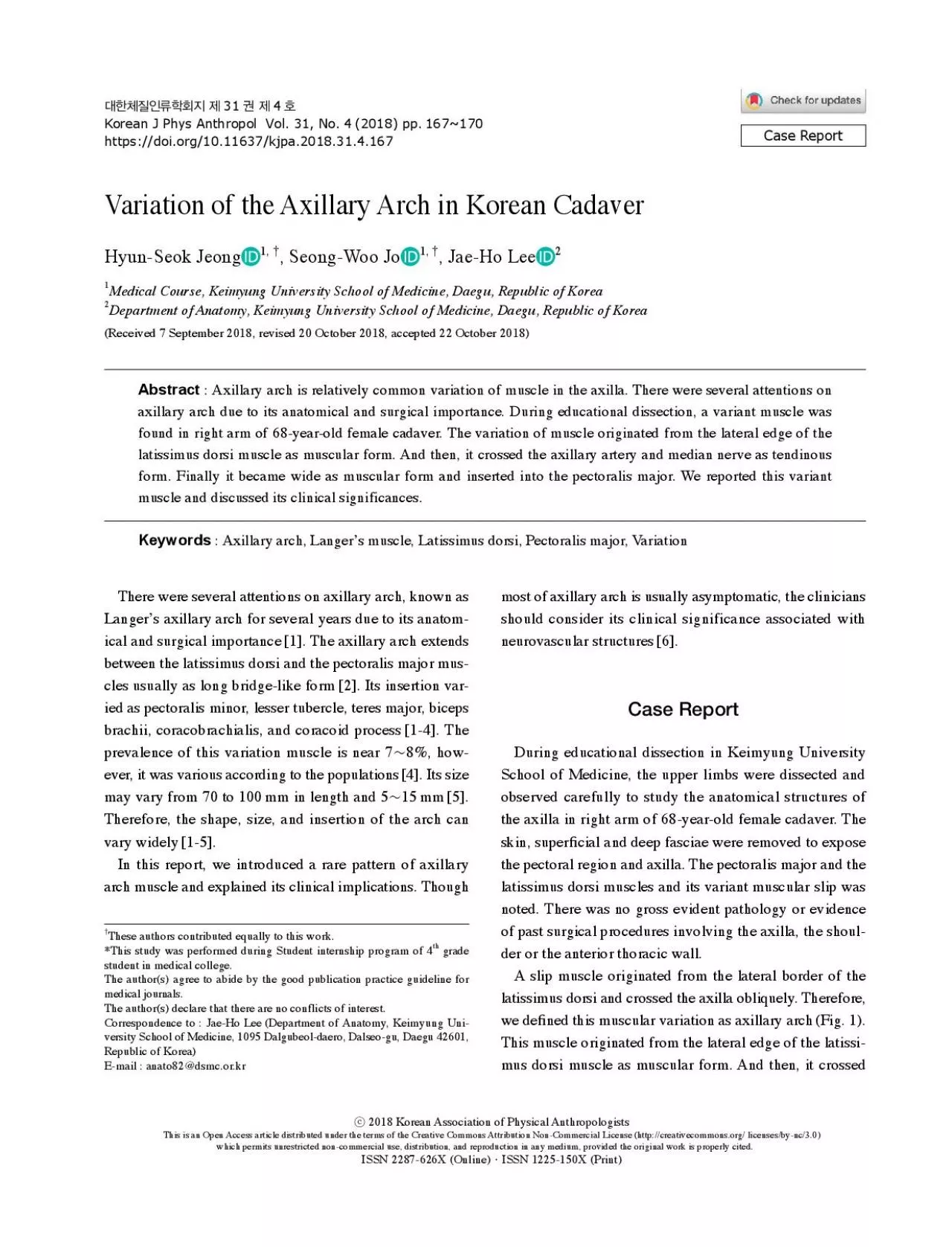

Variation of the Axillary Arch in Korean Cadaver SeongWoo Jo 1 JaeHo Lee 134 Case eport 168 HyunSeok Jeong SeongWoo Jo JaeHo Leethe axillary artery and median nerve as tendinous form ID: 937102
Download Pdf The PPT/PDF document "2018 Korean Association of Physical Anth..." is the property of its rightful owner. Permission is granted to download and print the materials on this web site for personal, non-commercial use only, and to display it on your personal computer provided you do not modify the materials and that you retain all copyright notices contained in the materials. By downloading content from our website, you accept the terms of this agreement.
2018 Korean Association of Physical AnthropologistsThis is an Open Access article distributed under the terms of the Creative Commons Attribution Non-Commercial License(http://creativecommons.org/ licenses/by-nc/3.0) Korean J Phys Anthropol Vol. 31, No. 4(2018) pp. Variation of the Axillary Arch in Korean Cadaver , Seong-Woo Jo 1,, Jae-Ho Lee † Case eport 168 Hyun-Seok Jeong, Seong-Woo Jo, Jae-Ho Leethe axillary artery and median nerve as tendinous form. This part measured 3.3 mm in length and 0.5 mm in width. the pectoralis major muscle. Its upper part inserted into the lateral lip of the bicipital groove of the humerus. There were no other variations, especially chondroepitrochlearis. And the origin and insertion of the pectoralis major and The first description of axillary arch was attributed to Its frequency varied from the 0.25% to 37.5%, depending in 7.4% (79/1,069) of patients with breast cancer [7], which is similar with Europeans and Japanese; lower in the Turk[4]. Embryological origin of the axillary arch has not been identi�ed yet. Axillary arch may be rudimentary remulus carnosus which is well developed in some lower mam[8]. However, additional information about its embryological aspect should be established further. (LD)
(MN). Pm, pectoralis minor. Axillary Arch Variation 169Axillary arch originated from either latissimus dorsi, whereas its insertion was extremely varied. Testut proposed the classi�cation of axillary arch as complete and incomplete according to its insertion[3]. The complete form incobrachialis muscle, the distal end of the bicipital groove, the inferior edge of the pectoralis minor muscle, or the coracoid process. Recent meta-analysis showed that one major muscle directly. Interestingly, axillary arch in our case showed a transition from muscle belly to tendinous [10,11]. It was suggested that additional muscle as tures in axilla due to limited space. Further study should cular compression syndrome, hyperabduction syndrome, racic outlet and shoulder instability syndrome[4,6]. This variation is also important in surgical �eld. During lymphadenectomy, it may obscure lymph nodes so that it leads inadequate clearance and increase recurrence[7,9]. In breast the arch is divided not properly it may result in �ap isch[10]. As axillary arch muscle may be palpable in living[4,9]. Moreover, axillary arch tended to coexist other muscular variation, [12]. Though other tence may induce unexpected and uncommon clinical con[6,7]. There
fore, clinician should be aware of know 1. Bergman RA, Thompson SA, A�� AK, Saadeh FA. Compendium of human anatomic variation. Baltimore-Munich: Urban & Schwarzenberg; 1998. 2. Langer K. Zur anatomie des musculus latissimus dorsi. Oester Med Wochenschrift. 1846; 15:16. 3. Testut L. Les anomalies musculaires chez l’homme. Paris: 4. Loukas M, Noordeh N, Tubbs RS, Jordan R. Variation of the axillary arch muscle with multiple insertions. Singapore 5. Standring S. Gray’s anatomy: the anatomical basis of clinical practice. 41st ed. New York: Elsevier; 2016. 6. Daniels IR, della Rovere GQ. The axillary arch of Langerthe most common muscular variation in the axilla. Breast Cancer Res Treat. 2000; 59:77-80. 7. Kil WH, Lee JE, Nam SJ. Clinical signi�cance of the axillary arch in sentinel lymph node biopsy. J Breast Cancer. 8. Yuksel M, Yuksel E, Surucu S. An axillary arch. Clin Anat. 9. Taterra D, Henry BM, Zarzecki MP, Sanna B, Pękala PA, Cirocchi R, et al. Prevalence and anatomy of the axillary arch and its implications in surgical practice: A meta-analysis. Surgeon 2018 May 22[Epub]. DOI: 10.1016/j.surge. Mérida-Velasco JR, Rodríguez Vázquez JF, Mérida Velasco JA, Sobrado Pérez J, Jimé
nez Collado J. Axillary arch: potential cause of neurovascular compression syndrome. Clin 11. V. The axillopectoral muscle(of Langer): report of three cases. Surg Radiol Anat. 2001; 23:341-3.12. Bergman RA. Doubled pectoralis quartus, axillary arch, chondroepitrochlearis and the twist of the tendon of pectoralis major. Anat Anz. 1991; 173:23-6. 170 Hyun-Seok Jeong, Seong-Woo Jo, Jae-Ho Lee 한국인 시신에서 랑거겨드랑활의 변이정현석, 조성우, 이재호계명대학교 의학과, 계명대학교 의과대학 해부학교실랑거겨드랑활은 겨드랑에서 흔히 나타나는 변이다랑거겨드랑활의 해부학적 그리고 임상적 중요성 때문에 이에 대한 관심이 많다세 여성 시신의 오른쪽 팔에서 근육변이가 관찰되었다이 근육은 넓은등근의 가쪽모서리에서 근육의 형태로 일어났다그 후 힘줄의 형태로 겨드랑동맥과 정중신경을 가로질러 지나간 후 넓어지며 다시 근육의 형태로 큰가슴근에 부착되었다우리는 이 근육변이를 소개하고 이것의 임상적 의의에 대찾아보기 낱말 랑거겨드랑활넓은등근큰가슴근교신저자 이재호계명대학교 의과대학 해부학교실전자우편 : anato82@dsmc.or.k